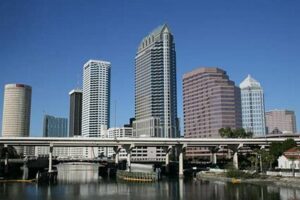The term “first city with skyscrapers” refers to the city that pioneered the construction of high-rise buildings, revolutionizing urban landscapes and architectural design. The title is commonly attributed to Chicago, a city in the Midwestern United States, recognized for its architectural innovation and the development of the skyscraper as we know it today.
Chicago’s architectural prowess emerged in the late 19th century, driven by factors such as rapid population growth, land scarcity, and technological advancements. The city witnessed the construction of several notable skyscrapers, including the Home Insurance Building (1885), the Rookery Building (1888), and the Monadnock Building (1891). These towering structures employed innovative techniques such as steel-frame construction, allowing for greater height and structural stability. The skyscrapers not only transformed Chicago’s skyline but also influenced architectural styles worldwide.
The development of skyscrapers in Chicago had far-reaching implications beyond the city’s borders. It sparked a wave of skyscraper construction in major cities across the globe, reshaping urban planning and design. Skyscrapers became symbols of economic prosperity, technological advancements, and architectural ambition, leaving a lasting legacy on the world’s skylines.
1. Innovation
Innovation played a pivotal role in the development of the “first city with skyscrapers.” It was the catalyst that drove architectural advancements and made the construction of towering structures possible. The city of Chicago, renowned for its architectural prowess, embraced innovation and became a hotbed for experimentation and new ideas.
One of the most significant innovations that paved the way for skyscrapers was the development of the steel-frame construction method. This technique involved using a framework of steel beams to support the weight of the building, allowing for greater height and structural stability. The Home Insurance Building, constructed in Chicago in 1885, is widely recognized as the first skyscraper to employ this innovative method.
Another crucial innovation that contributed to the rise of skyscrapers was the invention of the elevator. Prior to the elevator, buildings were limited in height by the number of stairs people were willing to climb. The development of safe and efficient elevators made it possible to transport people and goods to higher floors, facilitating the construction of taller buildings.
Innovation continues to shape the design and construction of skyscrapers. Architects and engineers constantly push the boundaries of what is possible, incorporating new technologies and sustainable practices to create ever more impressive and efficient high-rise structures.
2. Technology
Technology played a pivotal role in the development of the “first city with skyscrapers.” It provided the means to overcome engineering challenges, achieve greater heights, and accommodate growing urban populations. Chicago, recognized for its architectural innovation, embraced technology and became a hub for advancements in skyscraper construction.
- Steel-frame construction
The development of the steel-frame construction method revolutionized skyscraper construction. Steel beams provided greater strength and stability, allowing buildings to reach unprecedented heights. The Home Insurance Building, constructed in Chicago in 1885, is widely recognized as the first skyscraper to employ this innovative technique.
- Elevators
The invention of the elevator was another crucial technological advancement that contributed to the rise of skyscrapers. Prior to elevators, buildings were limited in height by the number of stairs people were willing to climb. Safe and efficient elevators made it possible to transport people and goods to higher floors, facilitating the construction of taller buildings.
- Building materials
Advancements in building materials also played a significant role in the development of skyscrapers. The introduction of new materials, such as reinforced concrete and fire-resistant cladding, improved the structural integrity and safety of high-rise buildings. These materials allowed architects and engineers to push the boundaries of height and design.
- Wind engineering
As skyscrapers reached greater heights, engineers had to address the challenges posed by wind loads. The development of wind engineering techniques helped ensure the stability and safety of these towering structures. Architects and engineers conducted wind tunnel tests to analyze wind patterns and design buildings that could withstand high winds.
The integration of these technologies transformed the construction industry and made the “first city with skyscrapers” a reality. Chicago’s embrace of innovation and technology laid the foundation for the development of skyscrapers and shaped the skylines of cities around the world.
3. Chicago
The connection between “Chicago” and “first city with skyscrapers” is deeply rooted in innovation, technological advancements, and a surge in urban growth. Chicago’s architectural prowess emerged in the late 19th century, driven by factors such as rapid population growth, land scarcity, and the city’s embrace of new technologies.
Chicago’s architectural innovation was evident in the development of the steel-frame construction method. This technique, first employed in the Home Insurance Building (1885), revolutionized skyscraper construction, allowing for greater height and structural stability. The city also witnessed the construction of other notable skyscrapers, such as the Rookery Building (1888) and the Monadnock Building (1891), which pushed the boundaries of architectural design and engineering.
The emergence of Chicago as the “first city with skyscrapers” had a profound impact on urban development and architectural trends worldwide. It sparked a wave of skyscraper construction in major cities across the globe, reshaping skylines and influencing architectural styles. Skyscrapers became symbols of economic prosperity, technological advancements, and architectural ambition, leaving a lasting legacy on the world’s urban landscapes.
4. Height
The connection between “Height” and “first city with skyscrapers” is inseparable, as the pursuit of height was a definin
g characteristic of early skyscrapers and remains a significant aspect of modern high-rise architecture. The desire to build taller structures was driven by several factors:
- Land scarcity: In densely populated urban areas, building upward allowed cities to accommodate a growing population without expanding outward.
- Economic competition: In the late 19th century, cities competed to construct the tallest buildings as symbols of economic prosperity and architectural prowess.
- Technological advancements: Innovations in steel-frame construction and elevator technology made it possible to build structures that reached unprecedented heights.
The Home Insurance Building, constructed in Chicago in 1885, is widely recognized as the first skyscraper. Standing at 10 stories tall, it was a groundbreaking achievement in height and engineering. Other early skyscrapers, such as the Rookery Building and the Monadnock Building, also pushed the boundaries of height and became symbols of architectural innovation.
The pursuit of height has continued to shape skyscraper design in modern times. Today, supertall skyscrapers, defined as buildings over 300 meters (984 feet) tall, dominate the skylines of major cities worldwide. These structures represent cutting-edge architectural design, engineering feats, and symbols of economic power.
Understanding the connection between “Height” and “first city with skyscrapers” provides insights into the historical and contemporary significance of these architectural marvels. It highlights the role of innovation, engineering prowess, and urban development in shaping the built environment.
5. Urbanization
The connection between “Urbanization” and “first city with skyscrapers” is deeply intertwined, with urbanization serving as a primary catalyst for the development and proliferation of skyscrapers. As cities grew denser and populations surged in the late 19th and early 20th centuries, the need for space-efficient and vertically oriented structures became increasingly apparent.
Urbanization led to a concentration of economic activity, businesses, and cultural institutions within cities, driving the demand for high-rise buildings that could accommodate the growing number of people and businesses seeking to locate in urban centers. Skyscrapers provided a solution to the challenges of land scarcity and high land prices in densely populated urban areas.
The “first city with skyscrapers,” Chicago, exemplified the close relationship between urbanization and the rise of skyscrapers. Chicago’s rapid population growth and economic expansion in the late 19th century fueled the construction of early skyscrapers, such as the Home Insurance Building and the Rookery Building. These structures became symbols of the city’s economic prosperity and architectural innovation.
The development of skyscrapers had a profound impact on urban landscapes, transforming city skylines and shaping the way people lived and worked in urban environments. Skyscrapers became landmarks and symbols of urban power and economic vitality, attracting businesses, residents, and visitors alike.
Understanding the connection between “Urbanization” and “first city with skyscrapers” provides insights into the historical and contemporary relationship between urban growth and architectural innovation. It highlights the role of skyscrapers in addressing the challenges of urbanization and shaping the built environment of cities.
6. Architecture
The connection between “Architecture” and “first city with skyscrapers” is profound, as architecture lies at the heart of skyscraper design and construction. Skyscrapers, as architectural marvels, represent the pinnacle of human ingenuity and engineering prowess, pushing the boundaries of design and redefining urban landscapes.
The development of the skyscraper as an architectural typology was driven by a combination of factors, including technological advancements, urban growth, and architectural innovation. Early skyscrapers, such as the Home Insurance Building in Chicago, showcased innovative use of steel-frame construction and elevator technology, enabling the creation of structures that reached unprecedented heights.
Skyscrapers have become iconic symbols of architectural achievement, with their towering presence shaping city skylines worldwide. They serve as landmarks and symbols of economic power, cultural identity, and architectural excellence. The architectural design of skyscrapers reflects the cultural and historical context in which they were built, showcasing various architectural styles, from Art Deco to Modernism and beyond.
Understanding the connection between “Architecture” and “first city with skyscrapers” provides insights into the evolution of architectural design, the role of innovation in shaping the built environment, and the cultural significance of skyscrapers as symbols of human ambition and architectural prowess.
7. Symbolism
The connection between “Symbolism” and “first city with skyscrapers” holds immense significance, as skyscrapers, particularly in their early stages of development, transcended their functional purpose and became powerful symbols imbued with cultural, economic, and architectural meanings.
- Economic Power and Prosperity
Skyscrapers, especially in their early years, were closely associated with economic power and prosperity. The ability to construct towering structures was seen as a testament to a city’s economic strength and ambition. The first skyscrapers were often built by wealthy corporations and individuals, who used these grand structures to showcase their financial prowess and dominance.
- Technological Advancements and Innovation
Skyscrapers also became symbols of technological advancements and innovation. Their construction required cutting-edge engineering techniques, new materials, and innovative designs. The successful completion of these architectural marvels demonstrated the ingenuity and capabilities of architects and engineers, pushing the boundaries of what was considered possible in construction.
- Urban Identity and Landmarks
Skyscrapers have become iconic landmarks, shaping the identity of the cities they inhabit. They serve as symbols of urban pride and cultural heritage. The unique designs and towering heights of skyscrapers make them instantly recognizable, creating a lasting impression on visitors and residents alike.
- Architectural Ambition and Prestige
The construction of skyscrapers was often driven by architectural ambition and the desire to create prestigious structures. Architects sought to design buildings that would stand out, not just in terms of height but also in terms of aesthetics and architectural significance. Skyscrapers became testaments to the skill and creativity of the architects who designed them.
In conclusion, the connection between “Symbolism” and “first city with skyscrapers” is multifaceted, reflecting the complex interplay between architecture, urban development, cultural values, and ec
onomic aspirations. Skyscrapers, as symbols of economic power, technological advancements, urban identity, and architectural ambition, continue to shape our cities and influence our understanding of the built environment.
FAQs on “First City with Skyscrapers”
This section addresses common questions and misconceptions surrounding the topic of “first city with skyscrapers,” providing informative answers to enhance understanding.
Question 1: Which city is widely recognized as the “first city with skyscrapers”?
Answer: Chicago, in the United States, is widely recognized as the “first city with skyscrapers.” The construction of early skyscrapers in Chicago, such as the Home Insurance Building (1885), marked a significant turning point in architectural innovation and the development of high-rise buildings.
Question 2: What factors contributed to the emergence of skyscrapers in Chicago?
Answer: Several factors contributed to Chicago’s emergence as the birthplace of skyscrapers, including rapid population growth, land scarcity, technological advancements in steel-frame construction, and the invention of the elevator. These factors created a fertile environment for architectural innovation and the pursuit of height in building design.
Question 3: What architectural innovations were crucial in the development of skyscrapers?
Answer: The development of steel-frame construction and the elevator were two crucial architectural innovations that enabled the construction of skyscrapers. Steel-frame construction provided the structural strength to support the weight of tall buildings, while the elevator made it feasible to transport people and goods to higher floors.
Question 4: How did skyscrapers impact urban development and skylines?
Answer: Skyscrapers had a profound impact on urban development and skylines. They allowed cities to accommodate growing populations within limited land space, and they became iconic landmarks and symbols of economic prosperity and architectural prowess. Skyscrapers transformed skylines, creating distinctive and recognizable urban landscapes.
Question 5: What is the symbolic significance of skyscrapers?
Answer: Skyscrapers often carry symbolic meanings, representing economic power, technological advancements, urban identity, and architectural ambition. They serve as landmarks that shape the identity of cities and stand as testaments to human ingenuity and the pursuit of architectural excellence.
Question 6: How have skyscrapers evolved since their inception?
Answer: Skyscrapers have evolved significantly since their inception. Technological advancements, new materials, and architectural innovations have enabled the construction of taller, more sustainable, and more aesthetically striking skyscrapers. Contemporary skyscrapers incorporate eco-friendly features, advanced building systems, and innovative designs, reflecting the changing needs and aspirations of modern society.
In summary, the “first city with skyscrapers” holds historical and architectural significance, symbolizing innovation, urban development, and architectural prowess. Skyscrapers continue to evolve and shape modern skylines, embodying the spirit of human ambition and the pursuit of architectural excellence.
Transition to the next article section
Tips for Understanding “First City with Skyscrapers”
To enhance your understanding of the topic “first city with skyscrapers,” consider the following tips:
Tip 1: Explore the historical context.
Tip 2: Study the architectural innovations.
Tip 3: Analyze the impact on urban development.
Tip 4: Examine the symbolic significance.
Tip 5: Consider sustainability and future trends.
“first city with skyscrapers”
“first city with skyscrapers”
Conclusion
The exploration of the “first city with skyscrapers” has unveiled the profound impact of architectural innovation and technological advancements on urban development and skylines. Chicago’s pioneering role in the construction of early skyscrapers left an indelible mark on the architectural landscape, transforming the way we live and work in cities.
Skyscrapers have evolved beyond their functional purpose, becoming symbols of economic power, technological prowess, and urban identity. They continue to push the boundaries of design and engineering, showcasing the ingenuity and ambition of architects and engineers. However, as we look to the future, it is essential to consider the sustainability and environmental impact of skyscrapers, ensuring that these architectural marvels continue to enhance our cities while respecting the planet.







